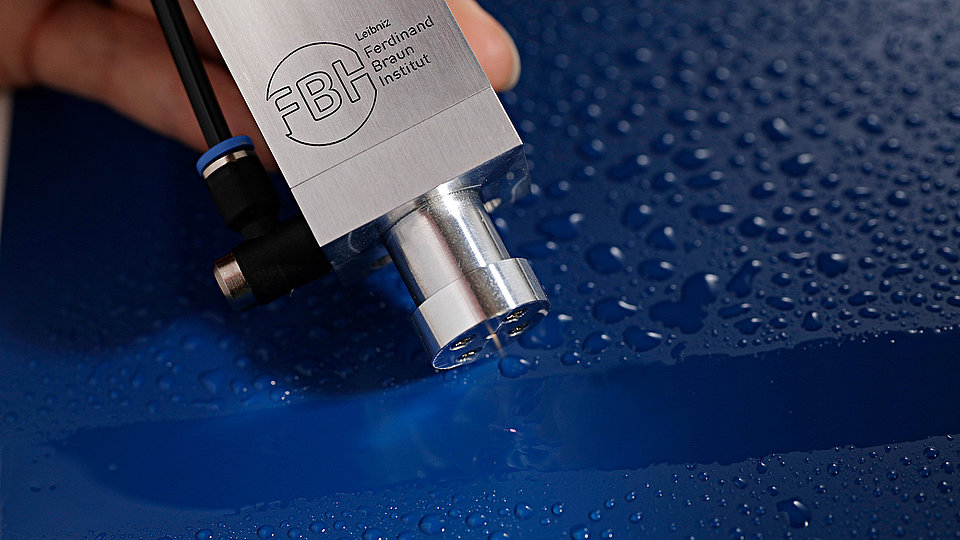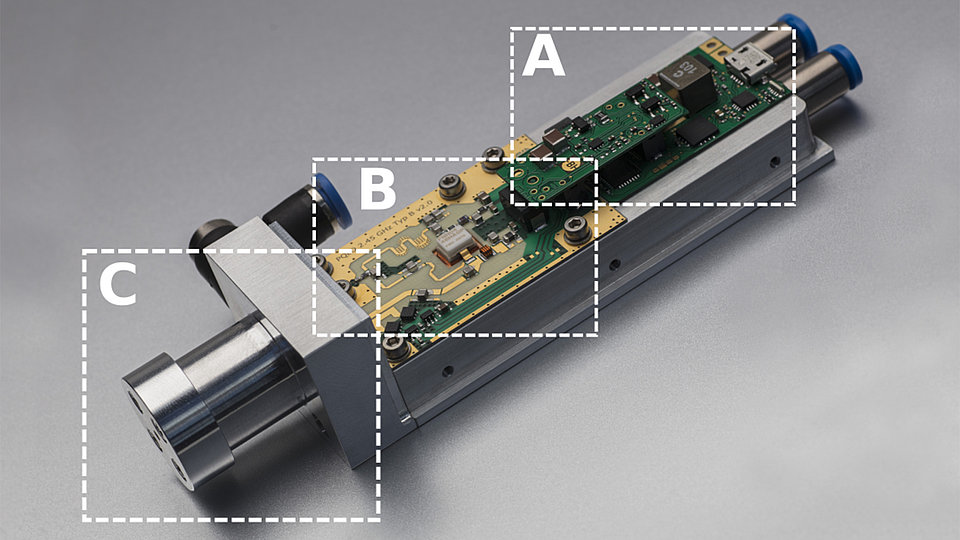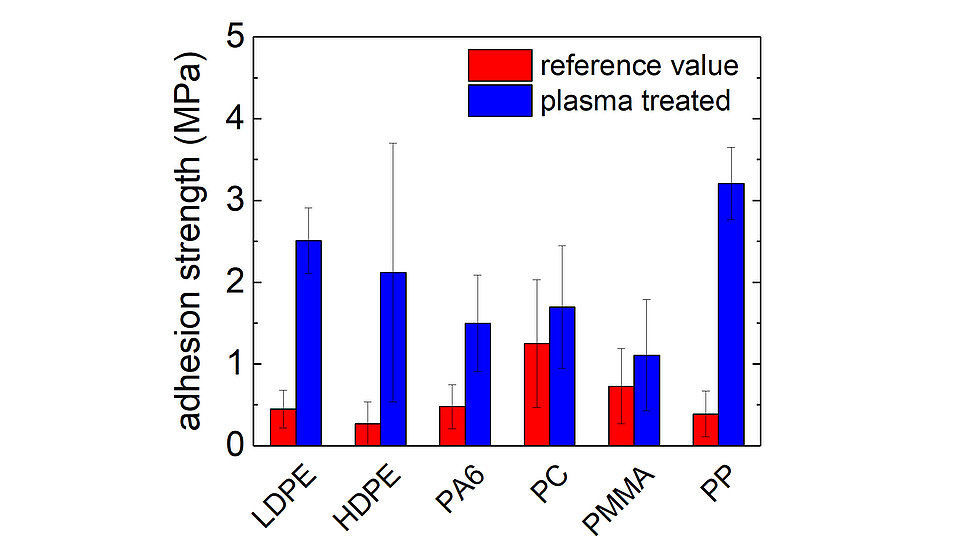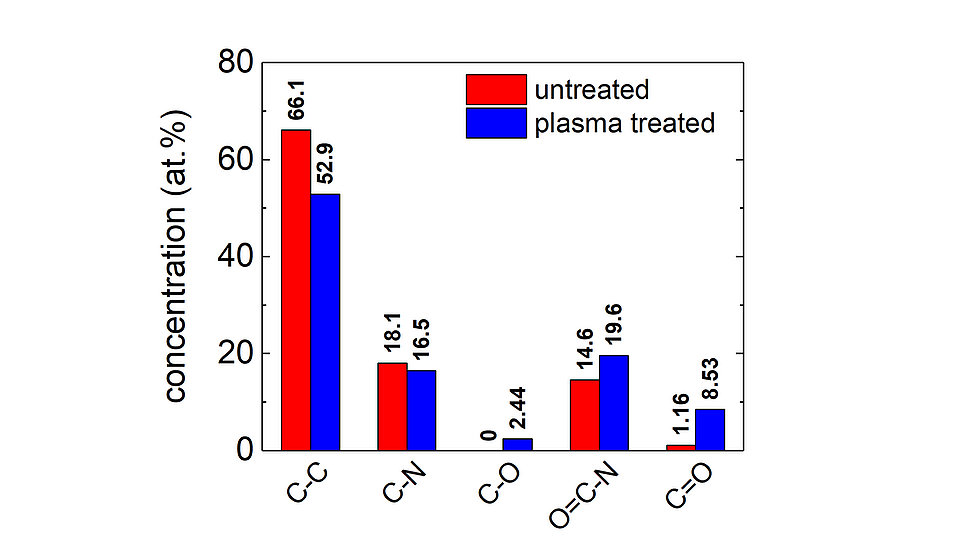Compact atmospheric pressure µ-wave plasma source for improved adhesion properties
Activation with FBH atmospheric plasma source: drops = not activated, smooth surface = activated surface.
Fig. 1: The plasma source (µPQ) can be divided into three main sections: control unit (A), microwave power oscillator (B) and resonator (C).
FBH has developed a compact atmospheric pressure µ-wave plasma source (µPQ) based on the plasma jet principle for multiple applications such as activation of surfaces (plastics, metals) in industrial production, cleaning and coating of surfaces. It can even be used for disinfection and wound healing. Initial tests at INNOVENT e. V. have shown that pre-treatment with the µPQ can significantly increase the adhesion strength of a polyurethane-based paint system to polymers such as polyamide (PA6), polypropylene (PP), polyethylene (LDPE and HDPE), polycarbonate (PC) and polymethyl methacrylate (PMMA). The µPQ could also demonstrate its capability during a micro-integration process of optical elements on silicon substrates. Integrated into the facility, the source was used for a cleaning process, yielding increased bond strength.
Compact µ-wave plasma source (µPQ)
The patented µPQ comprises of a microwave power oscillator, a resonator for plasma excitation in the 2.45 GHz ISM band, and a controller unit for easy plug-and-play applications, all integrated into a single, miniaturized package (114 x 33 x 25 mm³) (Fig. 1). Thanks to its small size and only three inputs for the 48 V DC power supply, water cooling and gas supply, it is easy to handle either as a stand-alone plasma tool or as part of a larger industrial system. This device has neither high voltage nor high frequency supply lines, which are known to be hard to handle and may radiate into the environment. The system can be operated using either water or air cooling for easy integration into production lines. The plasma generated by the µPQ is very homogeneous and has a low temperature, which is necessary for the treatment of temperature sensitive materials. This can be attributed to the high electron density and reduced ion mobility of microwave-driven plasmas. When used with air in the static regime, temperatures of about 200 °C are observed directly at the nozzle outlet. This temperature drops to 100 °C at a distance of 7 - 8 mm. In the dynamic regime, temperatures as low as 50 °C are reached. To obtain a variety of reactive species in the plasma jet, the plasma source can be operated using different gases including air, argon, oxygen and nitrogen without any hardware modifications.
Improving adhesion properties of polymers
In collaboration with INNOVENT e. V., the influence of µPQ plasma treatment on the surface properties of pre-treated polymers was investigated. PA6, PP, LDPE, HDPE, PC and PMMA were chosen as test polymers. Air was used as working gas for the µPQ, which flowed at 2 l/min. The overall power consumption of the plasma source was about 90 W with at least 20 W plasma output. After the plasma treatments, the samples were painted with a polyurethane-based paint system.
The wettability of the plasma-treated surfaces and the adhesion strength of the applied coatings could be significantly enhanced (Fig. 2). The observed improvements in adhesion strength can be attributed to the creation of new functional groups on the polymer surface. XPS measurements carried out on PA6 showed that the relative amount of single carbon bonds on the surface decreases significantly due to plasma treatment, while the amount of carbon-nitrogen and carbon-oxygen single bonds increases significantly (Fig. 3). Similarly, an increment in the relative proportion of carboxylic acid amide groups and carbon-oxygen double bonds is observed. The formation of these new functional groups leads to stronger physical bonds with the subsequently applied adhesive system.
Use of µPQ for micro-integration of optical systems
The micro-integration of optical systems enables many new applications where size, weight, and cost are crucial. At FBH, we use adhesive integration methods to assemble optical systems for miniaturization and integration in order to transition laboratory-based setups to field- and space-compatible devices. To improve the bond strength of the adhesive joints of fused silica glass blocks, the interface surfaces were cleaned with µPQ. The compact device was mounted directly into the micro-integration facility. Thus, the freshly cleaned and activated sample could be assembled directly after cleaning. The plasma is confined to a thin plasma jet, allowing a selective surface treatment, e.g, on substrates for optical assemblies. With this process we demonstrated an increase of a factor of approximately four in the shear strength of the bonds.
The experiments clearly show that the µPQ is an excellent tool for selective and local functionalization of surfaces to improve adhesion.
This work is partially supported by the German Space Agency (DLR) with funds provided by the Federal Ministry for Economic Affairs and Climate Action (BMWK) due to an enactment of the German Bundestag under grant number 50WM1949 and 50RK1978.
Publications
V. Faldu, O. Beier, A. Pfuch, K. Horn, J. Zender, D. Wolf, T. Filler, W. Heinrich, U. Winterwerber*, N. Lobo Ploch, “Polymer surface functionalization using a new µ-wave driven atmospheric pressure plasma-jet device”, (submitted to Journal of Plastics Technology).
M. Christ, A. Stiekel, C. Stölmacker, C. Zimmermann, A. Kassner, M. Wurz, M. Krutzik, “Micro-integrated optical systems and qualification of adhesive integration technologies for cold-atomic quantum sensors”, ICSO 2022 (submitted).
Patent
D. Wolf, “Resonator und Leistungsoszillator zum Aufbau einer integrierten Plasmaquelle sowie deren Verwendung”, Patent, DE 10 2020 100 872 B4 2021.08.05 (2021)



